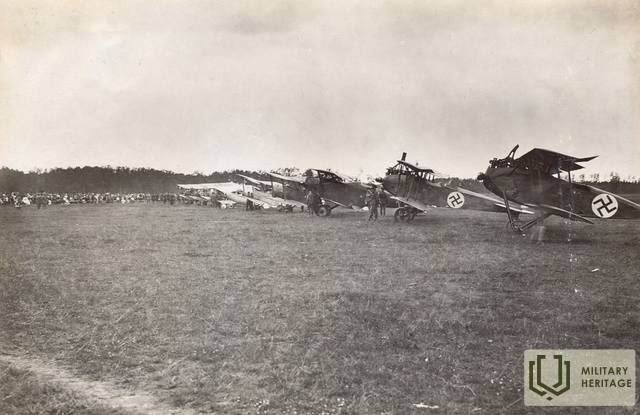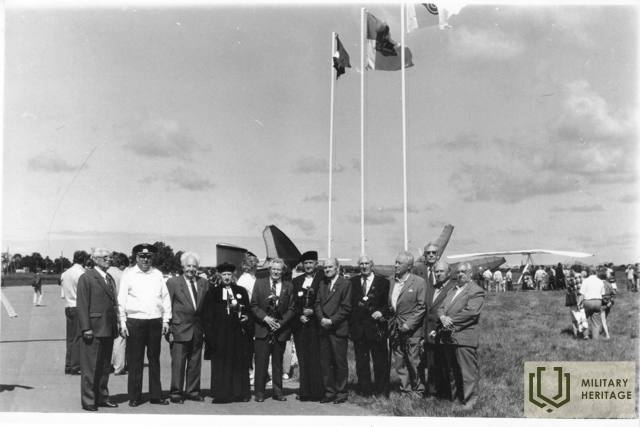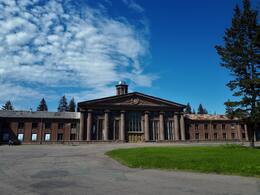United Aviation Day - a true national holiday
The narrator describes one of Latvia's most popular and widely attended events – the Aviation Festival in Spilve. He describes the course and scope of the festival. He emphasizes the popularity of aviation in Latvia.
“The United Aviation Festival — a true national holiday. Our united aviation — the aviation regiment, the defense aviation, civil aviation enthusiasts from the aeroclub and the youth — gathered at the Spilve airfield on Sunday to celebrate the annual aviation festival. The aviation festival has become more and more crowded year after year, attracting more and more visitors, so that it can be called a true national festival with full right. This designation is even more appropriate now, when interest in aviation has taken very deep roots in our people, when gliders are being built in all corners of Latvia, when miniature airplanes have already become every boy’s favorite toy. Therefore, the aviation festival that took place in Spilve on Sunday can be called a true national festival, not only because of the many tens of thousands of visitors, but also because it provides rich suggestions for national unity, strengthening the idea of defending our country and the awareness that only by making Latvia’s defense forces strong will we be able to live in peace and happily enjoy the fruits of their labor in our free Latvia. “(..) On Sunday, early in the afternoon, people from all over the country flocked to Spilve. Riga residents were taken there by boats and barges on the Daugava, buses, private cars and horse-drawn carriages, but those who were closer to home went there on foot. The Railway Board had assigned two special trains from Riga for the aviation festival, which received many holiday guests in Torņkam and Zasulauka. These crowded trains traveled along the Riga-Bolderāja line and then turned off along the railway branch to the airport in Spilve. . And so the whole of Riga flocked to Spilve. And not only Riga, because in that stream of people that flowed into the airport, there were a lot of sun-tanned faces of rural people, which was even more clearly evidenced by the self-woven skirts and coats. Soldiers and police maintained order, directing pedestrians along one side of the narrow Bolderāja highway and cars along the other. The parking lot was packed with various types of vehicles, and just by glancing at the buses and heavy trucks, you could tell from their signs that they had come a long way along both banks of the Daugava. The drivers had traveled with all their provisions and stopped there at intervals. The railways had also brought many aviation festival guests to Riga from various cities. A special tourist train had brought guests to Riga from Ventspils. Thus, two large streams of people, from the Daugava and along the Riga-Bolderāja highway, flowed unceasingly to the flag-draped Spilve and back until late in the evening. There were also thousands of "free listeners" in the hills of the White Manor; There, too, you could see unharnessed horses and people in friendly groups watching the festivities from afar. Of course, there was much that remained unseen and unheard, but still it was a satisfaction to be at least close to the aviation festival (..) “(..) While waiting for the guests of the festival at the hangars of the aviation regiment, flags also fluttered at the international airport. 37 aircraft were lined up in an impressive line at the airfield. There is also a new, beautiful and light aircraft built in the Liepāja military port workshop, which will be christened at the aviation festival. Anti-aircraft artillery was also stationed at the parade. Shortly before the start of the festival, information is broadcast over the loudspeakers, since all the guests of the festival know everything they need without asking (..) “(..) The public's attention was drawn to the bomber attack on the industrial center, which was truly impressive, built on the edge of the airfield with smoking chimneys. When the alarm sirens sounded, the "residents" left and then the bombers began to attack. Anti-aircraft guns roared, defending the "city", planes dropped "bombs" and finally the city caught fire. The impression of the battle was complete. It was the song that gave birth to the freedom of Latvia in the battles won. The program numbers were many and varied, and our columns are too small to list and describe them all. As in every big celebration, where tens of thousands of people converge (on Sunday there were over 50,000 at the airfield). The celebration lasted until dusk and at the end of it, the Minister of War, Gen. Balodis, through a loudspeaker, expressed gratitude to the military pilots, guards and civil aviation for their achievements. After the end of the celebration program, fireworks and dancing followed, as befits a national celebration. Donation by the Prime Minister. Prime Minister Dr. K Ulmanis has donated 100 lats to the aviation festival fundraiser. The aviation festival fundraiser is expected to be quite substantial (..)”
newspaper “Latvijas Kareivis”, No. 205, 1935. Article headline “United Aviation Festival – a true national holiday”
Related timeline
Related objects
Spilve airport
Located in Riga, Pārdaugava, in the Spilve meadows near Iļģuciems.
Spilve is famous in the history of military heritage for the grandiose Battle of Spilve in the 18th century and the Spilve airfield. Starting in the 20th century, it was used for testing aircraft, but during World War I it became a witness to the history of Latvian aviation.
During World War I, the Spilve meadows were used by the Russian army's air force for the purposes of fighting the German army. With the creation of Latvia, the airfield became the country's most important air force base and a training ground for pilots. The airfield's previous names were "Spilves Air Port" or "Riga Air Port", later "Riga Central Airport". It was the main airport in Latvia until the opening of the airport "Riga" in 1975.
Perhaps the Spilve airfield near Riga and the dream of reaching for the stars have contributed to the impressive achievements of many Latvian pilots. Perhaps, however, the beginning of Latvian aviation is much older and can be found in Priekule, where a Latvian blacksmith Zviedris made a flight from a church tower with a homemade device.
Today, the Spilve airfield is still in operation. You can see the airport building, built in 1954, which embodies the Soviet classicism or “Stalin Empire” style.
Sources:
Irbītis, K. Latvian aviation and its pioneers. Riga: Zinātne, 2004.
Brūvelis, E. History of Latvian Aviation: 1919-1940. Riga: Zinātne, 2003.
Official website of the state agency "Civil Aviation Agency". Available: https://www.caa.gov.lv/lv/latvijas-aviacijas-vesture-isuma [accessed 22.02.2021].







